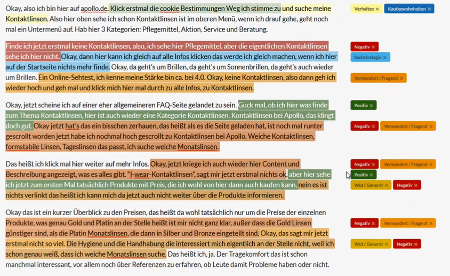The field of UX, usability and user research is still in its infancy–at least compared to the above-mentioned fields of research. Because of this, it comes as no surprise that technical support for the user research process and the evaluation of user-related data is still lacking. Especially when it comes to finding a system that lets researchers store data safely and in a discoverable way while also enabling them to define their own individual system to structure data, not much support is offered.

The difference between knowledge and insights lies in the data’s structure
This is a shame because structuring data and knowledge in a logical and understandable way is what generates insights. Simply possessing data–no matter how big the amount of amassed information is–will not necessarily help researcher gain applicable knowledge. Since the main goal of user-research is to uncover just these actionable pieces of insight we believe a flexible tool to support their efforts is needed.
Why we’re developing a flexible system for managing complex research data
In order to transform raw data into actionable insights, researchers first need a way to store, structure, explore, visualize, analyze and interpret every relevant kind of data (be it text-based, audio, video or any other imaginable kind of data). Ideally, this should all be possible within one tool or interface to minimize transactional overhead and maximize comparability, searchability, and discoverability of the data.Since the data user researchers, usability/UX professionals, and product designers work with on a day to day basis can differ wildly in terms of their structure and content, we consider it sensible to let users define their own guides, grids, and rules when it comes to exploring their data.
That’s why we aim to create consider.ly–a smart system based on a flexible tagging function. Researchers can structure, tag and annotate their data in any kind they want. By making said tags searchable across as well as within different documents and data sources we try to make connections more obvious and increase the discoverability of valuable insights.
Depending on their individual goals and questions they want to answer, researchers are free to subsume data into their own categories and tags. Obviously, the number of tags needed to fit everybody’s needs would be extremely high. Because of that not restricting researchers by presenting them with a number of default tags and categories but let them define their own structure freely seems to be the most sensible choice.

Enabeling researchers to define their own tags and categories is the first step towards structuring complex data
Designing an interface that works with complex data
Designers (especially in UX) usually aim to reduce complexity as much as possible and design complicated things in a way that makes them simple (to use). However, that might not necessarily be the best way to work when designing products that help users deal with complex data. When dealing with a complex field of work you sometimes have to accept that you won’t be able to simplify everything, especially if simplifying means restricting users in the way they want to work at the same time. Keeping in mind that user researchers are likely to care more about information density, interactivity, and individual ways to explore and connect their data we are developing ways to show underlying structures in data sets, possibilities to modify and annotate data and store data in one unified, secure place.Don’t only design for users but develop with them
Since there is still a lot to learn when it comes to designing a smooth data analysis experience, working closely with your user group is key. Implementing the wishes of power users and iterating upon their feedback will help you get better and most importantly closer to users wishes every day.To make sure consider.ly achieves maximum usability for our specific user segment we’re working closely with our current user base to determine, which features they need and how they tend to use them. Once we identify core functionalities that are needed (by talking to experts and users, developing prototypes and iterating them based on user feedback) the process of fleshing them out further and adding complementary features starts.
So far we’ve learned the most important thing when it comes to working with research data is helping people find exactly what they’re looking for. When dealing with amounts of data that are big to begin with and only keep growing as time goes on, tagging, searching and filtering are some of the most important features when trying to connect different pieces of knowledge to gain new insights.
Finding a system to structure data (especially the qualitative kind) isn’t easy. That’s why we’ll continue to learn from our work and our users to make sure we align our interface with our users mental model of how their data is connected, should be structured and stored. For the future, we plan to use our learnings to support researchers even further by employing AI for tasks such as transcription and automated emotion detection in audio as well as text files.



 in Germany
in Germany
Comments are closed.